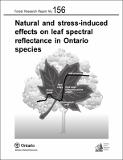Por favor, use este identificador para citar o enlazar a este item:
http://hdl.handle.net/10261/10712COMPARTIR / EXPORTAR:
 SHARE
BASE SHARE
BASE
|
|
| Visualizar otros formatos: MARC | Dublin Core | RDF | ORE | MODS | METS | DIDL | DATACITE | |

| Campo DC | Valor | Lengua/Idioma |
|---|---|---|
| dc.contributor.author | Mohammed, G. H. | - |
| dc.contributor.author | Noland, Thomas L. | - |
| dc.contributor.author | Irving, P. H. | - |
| dc.contributor.author | Sampson, P. H. | - |
| dc.contributor.author | Zarco-Tejada, Pablo J. | - |
| dc.contributor.author | Miller, John R. | - |
| dc.date.accessioned | 2009-02-17T08:38:54Z | - |
| dc.date.available | 2009-02-17T08:38:54Z | - |
| dc.date.issued | 2000 | - |
| dc.identifier.citation | Forest research report, no. 156 | en_US |
| dc.identifier.isbn | 0-7778-9387-8 | - |
| dc.identifier.uri | http://hdl.handle.net/10261/10712 | - |
| dc.description.abstract | This study explores some of the biological factors influencing leaf-based spectral reflectance, and endeavours to answer the questions: (1) Can Ontario plant species be satisfactorily distinguished by their leaf spectra? (2) Can spectral properties be used to identify physiological strain in plants before visual symptoms appear? and (3) How strongly do factors other than species and stress affect spectral properties? Forty-four species were examined for species effects. Some general patterns were revealed, including: low reflectance in the near infrared region for conifers compared to broadleaved species; higher reflectance in the blue wavebands for species with blue hues in their foliage; and more rapid decay of the green spectral peak in deciduous tree and shrub species. However, the influence of species was easily superceded by other factors, such as leaf age, leaf side, and stress status. The effects of stresses such as senescence and herbicide on leaf reflectance were evident prior to the appearance of visual symptoms such as chlorosis, browning, and reduced growth. The application of spectral indices was a useful means to quantify previsual changes in spectral reflectance. The red edge inflection point was well correlated with chlorophyll content, confirming previous studies. Pooling a range of coniferous species and stock types, the Photochemical Reflectance Index (PRI) was a promising early indicator of strain which may have broad application; within species, additional indices were useful. Normalized difference vegetation indices (NDVI) had limited correlation to pigments and other physiological indicators of stress status. Altogether, 11 indices reported in the literature were tested. These findings suggest that leaf reflectance may be an effective early indicator of physiological strain, and underpin our efforts to develop monitoring tools at remote scales to aid sustainable forest management. | en_US |
| dc.format.extent | 2925277 bytes | - |
| dc.format.mimetype | application/pdf | - |
| dc.language.iso | eng | en_US |
| dc.publisher | Ontario Ministry of Natural Resources | en_US |
| dc.rights | openAccess | en_US |
| dc.subject | Effect of stress | en_US |
| dc.subject | Spectral reflectance | en_US |
| dc.subject | Measurement | en_US |
| dc.title | Natural and stress-induced effects on leaf spectral reflectance in Ontario species | en_US |
| dc.type | capítulo de libro | en_US |
| dc.description.peerreviewed | Peer reviewed | en_US |
| dc.type.coar | http://purl.org/coar/resource_type/c_3248 | es_ES |
| item.fulltext | With Fulltext | - |
| item.languageiso639-1 | en | - |
| item.openairecristype | http://purl.org/coar/resource_type/c_18cf | - |
| item.openairetype | capítulo de libro | - |
| item.cerifentitytype | Publications | - |
| item.grantfulltext | open | - |
| Aparece en las colecciones: | (IAS) Libros y partes de libros | |
Ficheros en este ítem:
| Fichero | Descripción | Tamaño | Formato | |
|---|---|---|---|---|
| 9.pdf | 2,86 MB | Adobe PDF |  Visualizar/Abrir |
CORE Recommender
Page view(s)
487
checked on 24-abr-2024
Download(s)
2.075
checked on 24-abr-2024
Google ScholarTM
Check
Altmetric
NOTA: Los ítems de Digital.CSIC están protegidos por copyright, con todos los derechos reservados, a menos que se indique lo contrario.
